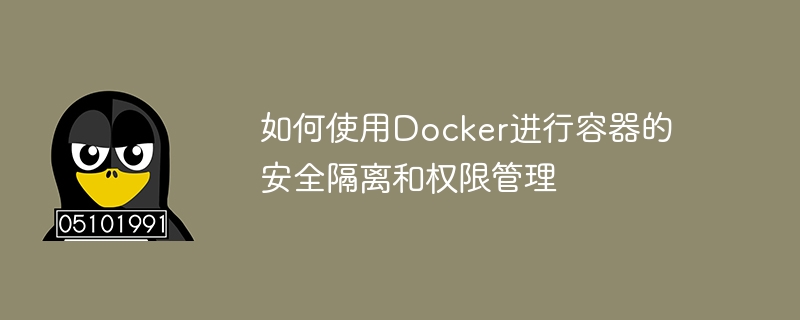Home >Operation and Maintenance >Linux Operation and Maintenance >How to use Docker for container security isolation and permission management
How to use Docker for container security isolation and permission management
- 王林Original
- 2023-11-07 10:19:44948browse

With the rapid development of containerization technology, security issues have gradually attracted people's attention. In a containerized deployment environment, the security isolation and permission management of containers are crucial. This article will introduce how to use Docker for secure isolation and permission management of containers, and provide code examples to help readers better understand.
1. Use users and groups for security isolation
By default, Docker uses root user privileges when running in a container. If not restricted, the container will have all the permissions of the host, which is obviously unsafe. Therefore, in order to make Docker containers more secure, we need to limit the permissions of the container. One way to do this is through security isolation through users and groups.
- Create new users and groups
First, we need to create a new user and group in the Docker image to limit the permissions of the container. Use the following commands to create new users and groups in the Dockerfile.
RUN groupadd -r mygroup && useradd -r -g mygroup myuser
This command will create a new user named "myuser" and add it to a new group named "mygroup". Use the "-r" parameter to set users and groups to system level.
- Switching Users and Groups
After creating new users and groups, we need to switch to the new users in the application in the container. This can be achieved by setting ENTRYPOINT or CMD.
USER myuser
Then, we can switch to the new group with the following command.
RUN chgrp mygroup /path/to/file
This command changes the group of the /group/to/file file to "mygroup".
2. Use container namespaces for security isolation
Container namespaces are a feature of the Linux kernel that allow for logical isolation of processes and resources. By using container namespaces, you can create isolated running environments between containers, thereby improving container security.
- Isolation Network
Using network isolation, you can isolate the container from the host and other containers. We can isolate the container from the private network using the following command.
docker run --net=bridge --name=mycontainer imagename
- Isolation PID
Using PID isolation, you can isolate the container from other processes on the host. We can isolate the container with a private PID using the command below.
docker run --pid=container:target_container --name=mycontainer imagename
- Isolate UTS
Using UTS isolation, you can isolate the container from the host. Use the command below to isolate the container with private UTS.
docker run --uts=private --name=mycontainer imagename
3. Use Seccomp for permission management
Seccomp is a function of the Linux kernel that is used to restrict process access to system calls. Using Seccomp, you can define system calls that a process is allowed to execute, thereby reducing the risk of a process exploiting privilege escalation vulnerabilities. In Docker, you can use Seccomp policies to limit the capabilities of a container.
- Create Seccomp configuration file
First, we need to create a Seccomp configuration file. You can use a text editor to create a file called "seccomp.json" and define the system calls allowed by the container.
{
"defaultAction": "SCMP_ACT_ALLOW",
"syscalls": [
{
"name": "write",
"action": "SCMP_ACT_ERRNO",
"args": [
{ "index": 0, "value": 1 },
{ "index": 1, "value": 2 }
]
},
{
"name": "open",
"action": "SCMP_ACT_ALLOW"
},
{
"name": "close",
"action": "SCMP_ACT_ALLOW"
}
]
}In the above example, the "write" and "open" system calls are allowed to be used, and the "close" system call is allowed to close.
- Apply the Seccomp policy to the container
Use the following command to apply the Seccomp policy to the container.
docker run --security-opt seccomp=./seccomp.json --name=mycontainer imagename
Here, we specified the seccomp.json file as the container's Seccomp policy configuration file when creating the container.
Summary
This article introduces how to use Docker for security isolation and permission management of containers, including using users and groups, using container namespaces, and using Seccomp. With the widespread application of containerization in the future, the security of containers will attract more and more attention. It is recommended that developers and operation and maintenance personnel must strengthen the security isolation and permission management of containers when deploying containers.
The above is the detailed content of How to use Docker for container security isolation and permission management. For more information, please follow other related articles on the PHP Chinese website!

